
| Ticker Tape Digest -Home | Subscribe To TTD | Sample TTD Pro Report | Sample TTD Report Limited | Sample a TTD Stock Market Video Show | Translate to any Language |

By Leo Fasciocco, Ticker Tape Digest

Ticker Tape Digest - February 7, 2003 - With the stock market — and especially technology issues — doing well through January, the first month of the new year, I am often getting calls from investors asking me, "Who do you think will be the next big winner in tech?"
Of course, everyone has his or her own opinion. Some analysts I speak with think there will be a big move in wireless stocks while others think semiconductor plays will make a big comeback. And, yet, others like selected plays on the Internet dealing with security, software or even retailing.
The answer: "Follow the Yellow Brick Road."
The yellow brick road?
Yes!
That is the course Dorothy took to find the Wizard of Oz and her way back home. If you remember the story, Dorothy and the friends she met on the way, the lion, the tinman and strawman, all had to overcome special problems to achieve their goals.
So it is with investors seeking to find the pot of gold at the end of the rainbow. The "brickroad" an investor needs to follow is the action of the stock market and movement of individual stocks. An investor will need to keep on the right path in seeking out potential big winners.
One way to do that is to keep track of leading stocks making new highs, companies showing big earnings surprises and firms with new products with potential to be big hits. The nasty witch, of course, will be throwing all kinds of obstacles in your way. They could be in the form of thunderbolt selloffs, surprise brokerage downgradings or quick market corrections.
One way to get a line on the top performing stocks is to find issues in up trends with a high ADX rating or a high Relative Strength rating from Investor's Business Daily. The ADX rating is a sophisticated technical tool developed by J. Wells Wilder.
It is one of several indicators used in what is called a Directional Movement System. eSignal subscribers can plot the ADX rating on charts by going to the analytics set-up and selecting Directional Movement (ADX/DMI). In simple terms, the ADX measures momentum.
Generally, a rating greater than 30 is very good for a stock in an up trend. Several tech stocks are showing high ADX ratings and are not well-known. They could continue to do well in the future and be surprise stars. Sina.com (SINA), an Internet media service company for Chinese communities worldwide, has an ADX rating of 51 based on eSignal's charting indicators as of mid-January. The stock surged from $2 last October to $9.50 — a 375 percent gain.
SINA offers on-line news, entertainment and community services in the Chinese language. It uses four localized websites that are produced from China, Hong Kong, Taiwan and North America. On January 10, SINA agreed to purchase Guangzhou Xunlong Technology Ltd., a vendor of wireless value-added services. The deal will double SINA's wireless business sales.
This year, analysts are looking for a profit of 20 cents a share compared with a loss in 2002. Revenue for SINA's latest quarter jumped 71 percent. Rediff.com India (REDF) has an ADX rating in eSignal of 50. The stock surged from 25 cents in October to $3.40. It is similar to Sina. REDF is an Internet portal focusing on items of interest to those in India. It covers community features, movies, cricket, email and chat. REDF showed a 60 percent increase in registered users in the fiscal second quarter ended September 30.
REDF is operating at a loss. So, it is still a very speculative issue.
One leading issue that is showing great earnings is Adtran Inc. (ADTN). It has an ADX rating in eSignal of 50. The company makes high-speed digital transmission products used by phone companies and corporate end-users to implement advanced digital data service.
ADTN earnings will be up 79 percent for 2002 to 81 cents a share from 45 cents a year ago. Looking to this year, the Street sees a 23 percent gain to 99 cents a share. The company has been exceeding quarterly Street earnings' estimates. That is due to higher-than-expected revenues and better margins due to cost reductions and a favorable product mix.
As you can see, many new names are popping up in technology already this year. Themes will emerge too, and the smart investor who is quick to spot them will profit greatly. Watching for new emerging leaders will be the key.
end
By Leo Fasciocco - November, 2002 - There’s nothing like taking an initial position and see it start to work for you immediately.
Many top traders advise if a new position starts to go against you right from the start, you are probably getting in trouble. For stock investors, it’s been a tough year on the longside. As I looked over the market action of the past year, I asked myself the question what: is “working” for the bulls.
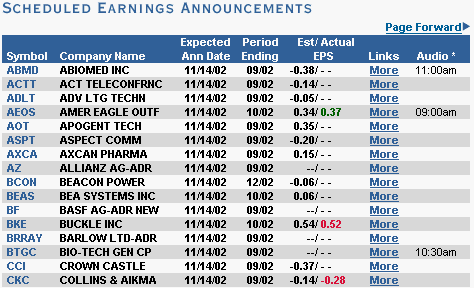
The answer: “Stocks with significantly positive earnings surprises.”
Some of this year’s big stock winners were companies that came in with a big earnings surprise. One of the best was little-known J2 Global Communications Inc. (JCOM), which ran up from $3.75 at the start of the year to 27. It puts out Efaxes and provides other internet services for communications.
Two other big winners were educational stocks. Corinthian Colleges Inc. (COCO) soared from 20.22 to 39.30 this year, Apollo Group (APOL) advanced from 30 to 45. HMOs were clicking too with Unitedhealth Group Inc. (UNH) pacing the way with a move from 70.80 to 96.40.
Most recently in the month of October Forest Laboratories Inc. (FRX), Autozone Inc. (AZO), Scripps E.W. (SSP), the publishing firm, all came in with big upside earnings surprises and their stocks were rewarded handsomely.
How can eSignal subscribers get in on these earnings-driven plays to improve their portfolio performance?
Well, the key is to find stocks of companies reporting much stronger than expected earnings, or making forecasts of great earnings. This can be done very easily by going to cbsmarketwatch.com’s web site.
The website has a feature section called “Earnings Watch” They do a great job of presenting the most important earnings forecasts of both positive and negative surprises throughout the day. Also, helpful is bloomberg.com and its earnings center and zacks.com and its section called “Top Positive Surprises.”
What you should be looking for are companies whose earnings surprise is significantly over what Wall Street analysts have been forecasting. Also, it is ideal if the earnings are higher than a year ago. A technical plus is if the stock is breaking out of a base on the news.
Make sure too, when checking for earnings surprises that any forecast made of future periods are favorable too. Don’t get tricked into finding a favorable earnings report only to later discover that they downgraded earnings for future quarters.
Of course it is ideal to get into these stocks as soon as possible after the earnings report is released. But, there are a few tricks to avoiding a few of the “lemons.” The stock must respond in a positive way to the earnings surprise. If it does not, forget it. There is something wrong. On the other hand, If it moves up a few points or more, don’t get scared, get aggressive and go after it.
An ideal scenario of playing an earnings surprise stock would go like this:
6 Stock continues in up trend and becomes a big winner in a bull market.
Sounds too easy to be true. Well, it can happen, especially with a potential bull market and a pick up in the economy in the offing. In the past few months, Forest Labs (FRX) surged from 74 in April to 97 by mid-October just on a strong earnings.
There will be others. Just watch for them every day.
end
Mr. Fasciocco’s articles appear at www.tickertapedigest.com. He is a contributing writer for several national publications. He is also president of Corona Investment Management. To get a free trial subscription to the Ticker Tape Digest Pro Report which comes out daily or the Ticker Tape Digest Technology Trader Report email freetrial@tickertapedigest.com. Mr. Fasciocco can be reached at leo@tickertapedigest.com.)
By Leo Fasciocco - I once asked a market historian why the symbol of a bull is used for up markets, and a bear for down markets.
His answer: A bull charges with its head down and then attacks by raising it. Hence a rising market. A bear rears back on its hind legs and attacks by falling down on its victim. Hence, a declining market.
There may be other explanations, but for me that suffices. The bear market that struck the Nasdaq market in April mauled a lot of investors. One I spoke with rode Verticalnet Inc. (VERT) down from 148 3/8 to 28 before capitulating. Ouch!
He said his faced turned white as a sheet when he clicked his mouse button to send in the sell order. Fortunately, he got in much lower than 148, but he did lose all his profits and some. The young investor admitted his mistake: “I was too greedy and too naive. I never thought the stock could fall that fast.”
The Nasdaq market itself fell 25% in one week during April. It did the same in just a few days back in 1987. Of course, the real damage is that individual stocks can often fall twice as much as the average. Thus, losses of 50% to 80% are quite possible.
One can draw a very important lesson from our young investor. Do not be greedy - a bull can make money and a bear can make money but a pig can not. Secondly, do not be naive in thinking the market always goes up.
The stock market taken on a daily basis has generally four phases that it goes through:
Learning to identify which phase you are in is basic. However, it is some times missed because of the “emotional blindness” caused by greed and fear. It takes a clear head, an objective view, and technical knowledge to identify each phase and take appropriate action.
Of course, individual stocks follow the same phases. It is extremely important to follow them because that is where the money can be made and protected from a bear market decline.
Like the bull analogy, markets that are in rally mode charge ahead. You will find high quality stocks breaking out of sound, well-formed bases. They will follow through and go into up trends. Money will be easy to make. That is what happened starting last Fall.
Stocks like Broadcom Corp. (BRCM) broke out for example. It cleared its base at 84. Three months later it was at 165 and still riding a solid up trend. Texas Instruments (TXN) and Nokia Corp. (NOK) are others that did well.
During the rally phase, the general market averages will show advancing days with expanding volume. Declining days will show mostly contracting volume. There will be a sense of ease in seeing stock plays turning profitable. Most investors experience an emotion of optimism. A bull market makes every look like a genius.
The topping phase is one of churning. The market averages will start to show little progress even on days of big volume. Another significant sign is that leading stocks during the rally phase begin to go sideways.
There is also a rotation of buying to stocks in lagging groups. It becomes more difficult to pick winners. Investor emotion turns to one of complacence - everything will be okay. However, this is the time to be on guard. Take some profits. Keep close tabs of your stops and monitor your sell strategy.
Then comes the decline and it can be swift. Some of the leaders start to breakdown - even on good news. In the bear market of April interment and biotech stocks came apart first. The market averages start to show heavy volume on down days, AKA distribution. It is at this time investors must act quickly to execute their sell strategies.
However, the naive investor, hesitates. He has not set up a sell strategy. He sees his stock, perhaps Verticalnet slump from 148 down to 104 in a week. He worries but takes no action. Then, the stock falls quickly to 88. He can not believe it. Then it goes into its downward spiral into the 20s. It’s a bear market. He’s been trapped.
The experienced investor is one though who executed his selling plan. He may have given back some of his profits. However, he is not greedy. He knows it is better to give back some rather than “fight the tape.”
Later, the market and many stocks begin to form a bottom. They start to go sideways with some false rallies and some shakeouts to the downside. However, the key is volume in individual stocks and the market starts to decline. The selling is abating. Stocks are starting to stabilize.
Finally, after several weeks or months, the market comes back to life. The market averages turn up with strong volume. A new rally is born from the ashes of the prior decline. New leading stocks emerge from bases. They may not be the leaders of the previous rally.
That is the fake out. Those who held certain stocks through the decline are not in the right issues for the new advance. The market has “shuffled the deck.” It is a new bull market with new leaders and new names.
end
By Leo Fasciocco - Bull markets come and bull markets go. Then they come back again. So it is with the oil service stocks.
Back in 1996 and 1997, the oil service stocks enjoined the wonders of a bull market with many of the issues quadrupling and some doing even better than that. Then they topped in early 1998 and went into a nightmarish bear market. The reason a decline in crude oil prices.
Now (Feb. 2000), with crude hitting $30 a barrel, the oil service and drilling stocks are once again doing well. The higher price of crude means the big oils will be spending more to drill. That helps the service companies to leverage their operations and show better profits.
The average investor might shy away from the oil service stocks for two reasons. Many of the companies have shown declining earnings the past several quarters. Secondly, the industry groups - drillers and oil service - are not ranked very high yet compared with other groups.
Nevertheless, one should not be faked out.
There are other factors, though, that make the sector very attractive. Many of the stocks are now hitting 52-week highs. They include: BJ Services Inc. (BJS), Noble Drilling Corp. (NE), Rowan Cos. (RDC) and Global Marine Inc. (GLM). There are others.
Secondly, earnings projections for the next several quarters call for some impressive comparisons. The whole fundamental and technical pattern of the group is akin to that back in 1995.
Industry group moves play a big roll in coughing up big wining stocks. The key for an investor is to quickly identify the "leaders." Of course, when we say "leader" we do not mean the biggest company in the industry. No we mean the stock that moves out of its basing formation first and climbs the fastest. The stock actually "leads."
There are some good clues to spot the "leader." They are:
So, who fits the "leader" profile?
BJ Services is one stock.
It was one of the first to move up from a bottoming formation a year ago in March. It was 19 at the time. It trended higher nicely. Most recently, BJ emerged from a base on Jan. 7 cutting across key resistance at 43. The stock is now 50 7/8.
BJ made a new 52-week high and is poised to make a new all-time high. The stock has an 81 Relative Strength rating from IBD. That means the stock outperformed 81% of all stocks the past 12 months. If one were to watch the tape, they could easily notice that BJ tends to move strongly when the oil service stocks do.
Finally, the clincher is that BJ is one of the first oil service firms to not only show an up turn in quarterly earnings - it also surpassed the highest estimate by Street analysts. That is a very bullish omen. It means the Street underestimated BJ's earnings outlook.
On Jan. 7, when BJ's stock moved higher, it reported a 150% increase in earnings for the fiscal first quarter ended Dec. 31. It came in with 25 cents a share compared with 10 cents a year ago. Results were 30% above consensus Street estimates. Revenues rose 21% - the first improvement after six quarters of lower results.
This year, analysts expect BJ's profits to climb to $1.17 a share from a depressed 11 cents in 1999. Going out to 2001, they see a 62% jump in net to $1.90 a share and for 2002, a 44% gain to $2.73 a share.
Of course, things could change. Nevertheless BJ Services is the classic leader one should seek in a strong group. It has great potential to do well.
By Leo Fasciocco - To know something about a company or a stock that no one else knows is the desire of most investors. That is why "tips" and "rumors" abound in the market and people buy and sell stock on them.
However, there in lies a trap that has snared many investors.
Some nefarious market players use "rumors" to catch the unwary tricking them into selling or buying a stock. The trap comes when just the opposite of the rumor comes true.
Take the case of Chrysler Corp. (C). In November 1994, the stock slipped from 48 to 45 in a few days following "talk" that investor Kirk Kerkorian, holder of 9%, of Chrysler, was going to take some kind of action. There was speculation he might sell his holdings.
The concern for investors was that the additional supply of stock for sale coming into the market would depress the price of the stock. However, a few days later on November 14, Chrysler's stock gaped higher at the opening and ran up 4 7/8 to 49 for the day.
The news: investor Kerkorian announced that he was going to try to buy more Chrysler stock to increase his stake to 15%. He would seek to push Chrysler to take action to increase shareholder value by buying back stock or raising the quarterly dividend.
Obviously, the rumor of Kerkorian selling out was false. No one in the press knows exactly how it got started. But, it surely threw some people off who "bit on the bait of the rumor."
However, those who watched the tape action of Chrysler could see the rumor of Kerkorian selling Chrysler's stock did not match up with the price and volume action.
Ticker Tape Digest spotted it for its followers by noticing the jump in "positive tick volume" on an hourly basis. Tick volume is an excellent indicators follow accumulation and distribution.
When Chrysler's stock went into its intraday decline, there were four sharp spikes up showing "unusual" accumulation on an hourly basis.
Also, the largest spike up in accumulation occurred just three hours, before the news broke about Kerkorian's plans to buy more of the stock.
It would take some digging to find out who, or what institution was doing the accumulation. Also, it's not certain if Kerkorian or associates were buying the stock for themselves.
The important thing for investors to have know is that the action of the stock did not match the rumor of a possible sale.
Although, Chrysler's stock declined in price for those few days, there was definitely aggressive buying going on by someone under the cover of the sliding price.
If the "bearish rumor" were true, then Chrysler's stock should have shown a clear indication of distribution and at the most only mild buying. It did not.
In today's markets rumors and speculation abound. There has been a pick up in takeover speculation. Quaker Oats Co. (OAT), Allergin Inc. (AGN) and Black & Decker Co. (BDK) are a few of the stocks that at this writing have been mentioned as buyout possibilities. There will be more.
Also, certain publications such as U.S.A Today and Business Week will circulation the latest Street gossip. There are also 900 lines talking about "whisper stocks."
Investors will do well always to listen to the tape before the tip. Of course, in some cases, the tape action of a stock and the rumor will blend nicely and sometimes a look into the recent trading pattern of the stock will reveal "unusual" action that will make the rumor or speculation more believable.
United Inns Inc. (UI), for example, was a buyout speculation. The stock moved up sharply on higher volume that indicated good accumulation. It rose from 15 to 19 1/2 in four weeks. So, the tape seemed to confirmed the speculation of an imminent takeover. It happened.
However, an investor must never forget that the stock market has and always will be influenced by "tips" and "rumors."
The first rule is always to be skeptical and to check the trading pattern of the stock. If the action does not confirm the rumor, hands off.
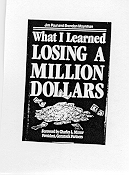
By Leo Fasciocco -
"What I learned losing a Million Dollars."
That's the unique title of a book published by Jim Paul, who was a vice president in charge of Dean Witter Reynolds International Energy unit in New York.
The book is a bit of a biography, a confession and a drama. But, to any aspiring investors, who wants to improve their performance, it's a good lesson in how to avoid getting trapped and crushed by the market's volatile movements the way Paul did.
Our story picks up with Paul rising through his career to be a trader and finally a member of the Chicago Mercantile Exchange's board of Governors and Executive Committee in the early 1980s.
He had been trading lumber, but when that market dried up he switched to soybean oil. In early 1983, he started building bull spread positions in soybean oil.
Paul was bullish. His strategy was to go long the nearby month and short a deferred month. If there was a shortage and supplies got tight, the nearby month's price would go up faster than the deferred month and he would make money.
In August 1983, the U.S. Agricultural department made a report indicating damage to the soybean crop. The news should have sent soybean prices higher profiting Paul. But, instead they went limit down for a few days.
As Paul relates in retrospect: "The oldest rule in trading is if a market is hit with bullish news and goes down sharply instead of up something is wrong."
However, Paul held believing he was right and the market was wrong. By September, the tide turned in his favor and his bean trade started to click. In one day alone, he made $248,000 on his position. His thoughts: "I am going to get rich." He went looking for a $400,000 motorhome and bought a Porsche 911 convertible.
Then the soybean trade gradually began to turn against him. The decline was relentless. His friends bailed out. Paul didn't. He began to rationalize. His friends lacked courage to hold their position. He was in for the long pull. This was going to be his big trade.
As Paul's trade got worse he kept saying to himself: "It's going to turn tomorrow. It didn't. He borrowed money to meet margin calls but that ran out. Finally, his position was "mercifully" liquidated by the brokerage firm. Net loss: $1.2 million - a wipeout.
After suffering the emotional and personal humiliation of losing his money, Paul set out to find out how the great ones made their money trading.
He became bewildered at first.
Jim Rogers: "I haven't met a rich technician
Marty Schwartz: "That's nonsense. I got rich as a technician.
John Templeton: "Diversify you investments."
William O'Neil: "Diversification is a hedge for ignorance."
Peter Lynch: "You have to understand a business so you know when to buy more of the stock when it goes down."
William O'Neil: Averaging down is an amateur strategy that can produce serious losses.
Then Paul realized there is no "Holy Grail" to making money in the markets.
Then, he studied what the successful investors said about losses and it all came together.
Marty Schwartz: "The most important thing in making money is not letting your losses get out of hand. I am more concerned about controlling the downside."
Paul Tudor Jones: "I am always thinking about losing money as opposed to making money. Don't focus on making money; focus on protecting what you have.
Warren Buffett: "The two rules of investing are try never to lose money and the second is never forget rule one."
William O'Neil: "Most unskilled investors stubbornly hold their losses. They could get out cheap but being emotionally involved they keep waiting and hoping until their loss gets big and cost them dearly."
Bernard Baruch: "Learn to take losses quickly and cleanly. Don't expect to be right all the time. If you make a mistake, cut your loss quickly."
The moral of Paul's story is that there is more than one way to make money in the markets - and those that have done it have used a variety of approaches some even contradictory.
The key is to learn how not to lose big money. There will be losses - and that's part of investing - learning to take them when they are small is what's important.
end
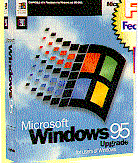
By Leo Fasciocco - Microsoft Corp. (MSFT), Amgen Inc. (AMGN), Reebok International Ltd. (RBK)!
These are just a few stocks investors have come to know as successful investments. But in their early days, they were not well known by the average investor. When they made their debut in the 1980s, they were "new names."
When the stock market becomes difficult, it is then investors should be doing their homework and looking for "new names."
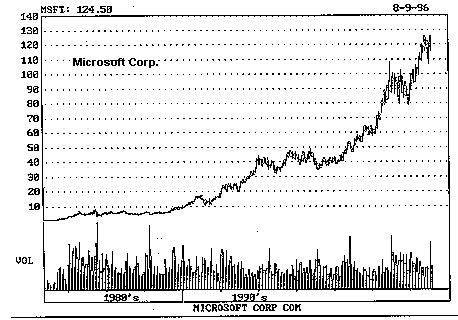
When the stock market moves higher again, certain "new-name" stocks will most likely catch the fancy of many investors and institutions and score big gains.
How do you uncover potential top performing "new-name" stocks?
The answer is to keep track of the new issues' market.
Many publications have information on new issues. Investor's Business Daily newspaper has a new-issues section listing stocks that have recently gone public or plan to make an initial offering. The list gives the ticker symbol of these new stocks and other extremely important information.
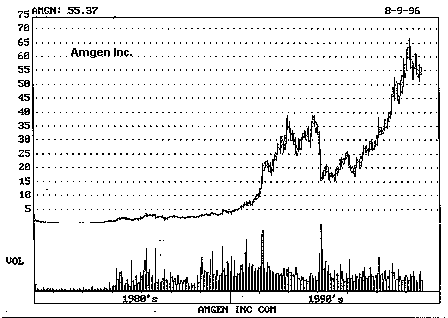
You should make a list of those stocks and follow their progress. Better yet, one should use a good charting software program to follow the stocks and be able analyze them with a moving average, momentum indicator or other technical tool. Also, look for them when scanning through TTD's web page.
Of course, fundamental research is need to weed out the good "new-name stocks" from the bad. Information can be obtained by calling the underwriter for a prospectus or a brokerage firm for a research report.
A good new-name stock should be one with:
Take SPS Transactions Services Inc. (PAY) as an example.
The stock came public at $8 a share in February 1992, adjusted for a split. It doubled to $16 rapidly. It was formed by Sears Roebuck & Co. (S) in 1985. SPS handles point-of-sale credit account verification and private label credit card programs. That service was growing rapidly.
SPS's goal was to expand point-of-sale processing to the healthcare, insurance, grocery and fast-food industries. Earnings the past three quarters at that time soared 107%, 135% and 110%. Profit growth was projected at 20% a year.
Eleven mutual funds held SPS and include Fidelity Growth Fund and the Brandywine Fund.
SPS soared to 30.
There are "new-name" stocks coming out all the time. Not all of them will be a Microsoft or an Amgen, but quite a few should do very well. If you keep close tabs of the new issue's market you should profit handsomely by following TTD's "golden rules for new issues."
end
(Copyright: Ticker Tape Digest - All rights reserved)